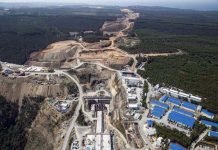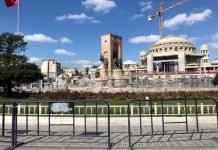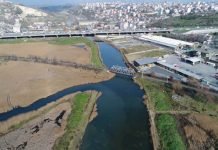Residents of Istanbul’s Kadıköy district have been protesting plans to turn a 12,000-square-meter area designated for disaster coordination and assembly zones into a luxury housing project, warning that the move sacrificed vital public space and earthquake preparedness for profit, the BirGün daily reported.
The Istanbul Regional Directorate of Foundations has put up for auction as a housing project an area in the historic Caferağa neighborhood. The area includes a family health center, football fields, a 300-car parking lot and several disaster stations.
Residents and environmental activists have warned that the housing project poses an environmental threat as it would destroy a large green space and eliminate a crucial safe area for use during disasters like earthquakes.
The controversy has erupted against the backdrop of Istanbul’s precarious earthquake preparedness. The megacity of 16 million sits on the North Anatolian Fault, with seismologists warning of a major earthquake risk that could affect millions of residents.
Hanife Dağıstanlı, a neighborhood representative, criticized the tender as unlawful, claiming authorities pushed ahead without consulting local municipalities or cultural preservation boards despite the area’s status as a third degree archaeological and urban conservation site. “This is our last green space and the only open area for disaster coordination. We will defend our rights [by protesting] as well as in court,” she said.
Under Turkish law, third-degree archaeological sites require special permits and oversight from cultural preservation committees before any development can proceed. The designation typically protects areas with historical significance while allowing limited, carefully regulated construction.
Local civic groups, including Kadıköy Urban Solidarity, echoed those concerns, accusing authorities of prioritizing profit over public safety. Activist Üzeyir Uludağ warned that the housing plan could pave the way for commercial exploitation, saying, “This isn’t just about a few apartments. It’s an attempt to seize public space under the guise of development.”
Kadıköy Mayor Mesut Kösedağı backed residents’ legal objections, arguing that tenders cannot proceed in areas lacking proper zoning plans. “This is an archaeological and urban conservation site. We urgently call on the General Directorate of Foundations to reverse this decision,” he said.
Istanbul residents have long complained about the lack of safe spaces in the face of disaster. Following a magnitude 6.2 earthquake in April 2025 locals were left vulnerable as assembly zones had become construction sites.
People took to social media to express their frustration and outrage over the lack of accessible open spaces in which to seek refuge during emergencies.
Earthquake assembly zones in Turkey were first officially established after the 1999 İzmit (Marmara) earthquake, a magnitude 7.4 quake that killed over 17,000 people and revealed major gaps in urban planning and disaster preparedness. The government and the Disaster and Emergency Management Authority (AFAD) began designating open-air gathering areas to improve emergency response, particularly in high-risk cities like Istanbul, Ankara and İzmir.
By 2019 AFAD reported 2,864 such areas in Istanbul, though figures vary. Istanbul Mayor Ekrem İmamoğlu cited over 800, while the Union of Chambers of Turkish Engineers and Architects (TMMOB) noted that many designated zones had been built over, leaving only about 77 meeting official standards. In contrast President Recep Tayyip Erdoğan claimed there were “tens of thousands” of assembly areas.
Civil society groups, urban planners and seismologists have repeatedly warned that a large portion of these zones fail to meet safety criteria, with three-quarters of the original post-1999 sites repurposed for residential, commercial or shopping developments.















